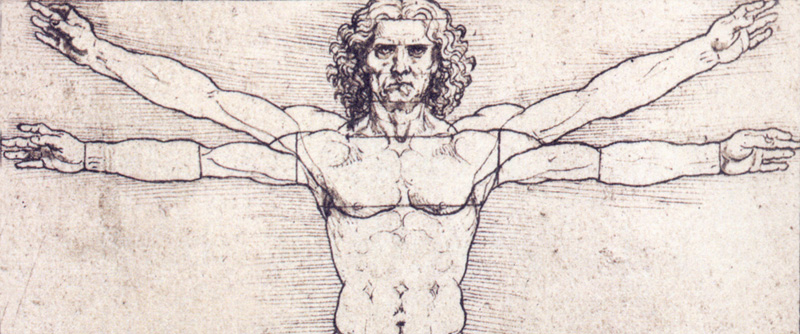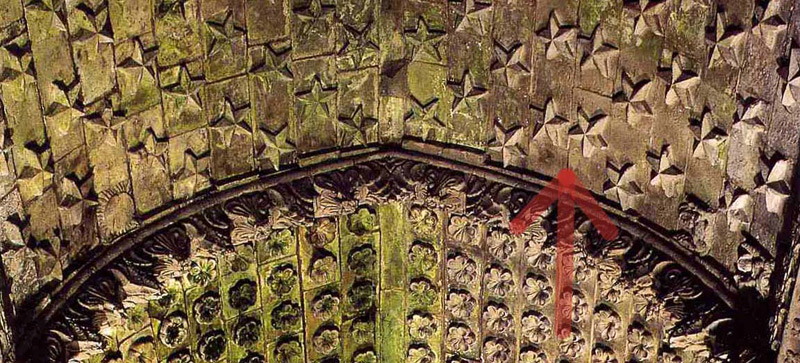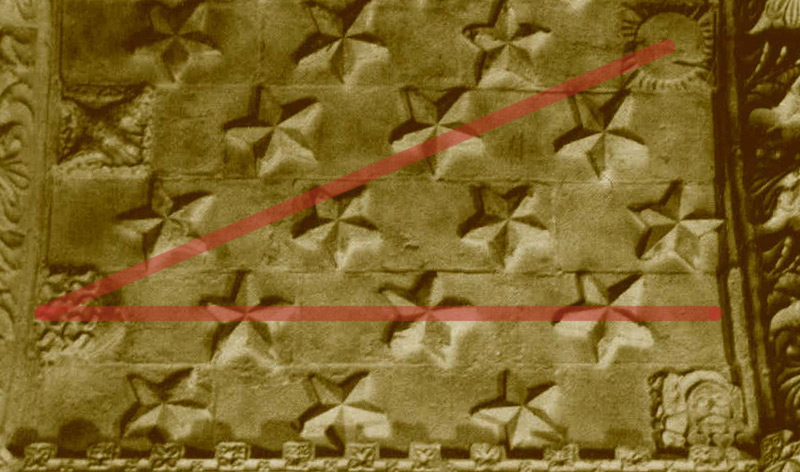(Originally published in Atlantis Rising #63 – May/June, 2007. Rosslyn Chapel ceiling photos are by Antonia Reeve for the Rosslyn Chapel Trust)
In “Return to Rosslyn Chapel,” published in Atlantis Rising #48, I revealed my discovery of a Lorraine Cross encoded in Rosslyn’s five-course vaulted ceiling. Wayne Herschel, author of 2003’s “The Hidden Records,” has now added another layer to the mystery by claiming that a Vitruvian Man, a symbol made much of in Dan Brown’s “The Da Vinci Code,” is also encoded there. His claim has led me to Rosslyn’s darkest secret.I had discovered the cross when, upon looking at the ceiling, I noticed that the architectural elements of the second and fourth courses looked uncomfortably crowded. As a trained graphic artist, whose job it is to bring visual order to chaos, I naturally wondered why.Pushing the crowding elements out to the left and right of the ceiling, until all of the elements were harmoniously spaced, revealed the two-barred Cross of Lorraine.While it is not within the scope of this article to repeat my theories about why a Lorraine Cross would be encoded there, it will be useful to keep in mind the following:
- It is upside down. The shorter bar, symbolizing the INRI sign put above the head of the crucified Christ, should be above the longer.
- Today’s Sovereign Military Order of the Temple of Jerusalem (SMOTJ) uses the same reverse-barred configuration in its official insignia, but does not say why.
- An equal-barred Cross of Lorraine was the first insignia granted to the Knights Templar. In Dagobert’s Revenge, Boyd Rice says that the equal-barred cross represents “the union of opposites, the intersection of creative force and destructive force, or the union of male and female principles;” that the bar “above” mirrors the bar “below” and, as such, is symbolic of the Hermetic maxim, “as above, so below.”
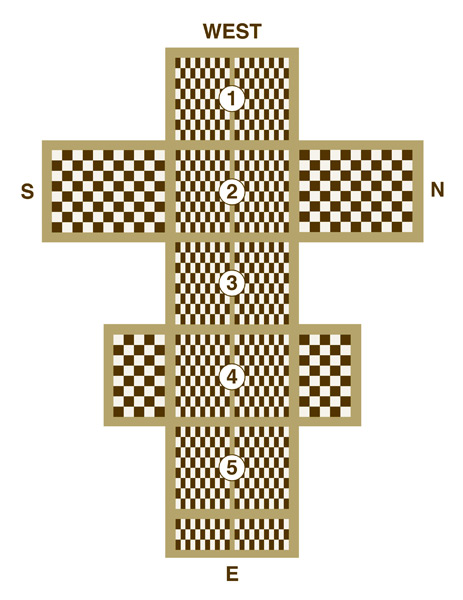 A few months ago a friend sent me a link to a page on Wayne Herschel’s website which showed how Herschel had combined a modified version of Leonardo Da Vinci’s iconic Vitruvian Man with my graphic of Rosslyn’s Lorraine Cross. While the arms of Leonardo’s man are shown at both the 3- and 9-o’clock positions and the 2- and 10-o’clock positions, allowing him to graphically describe the proportional relationships of the human body to a circle and a square, Herschel had eliminated the 2- and 10-o’clock positions and added a 12-o’clock position, allowing him to show how human proportions relate to a pentagram. Herschel’s modification was based on a treatise that Leonardo was himself inspired by—a description of human proportions by ancient Roman architect Marcus Vitruvius Pollio.
A few months ago a friend sent me a link to a page on Wayne Herschel’s website which showed how Herschel had combined a modified version of Leonardo Da Vinci’s iconic Vitruvian Man with my graphic of Rosslyn’s Lorraine Cross. While the arms of Leonardo’s man are shown at both the 3- and 9-o’clock positions and the 2- and 10-o’clock positions, allowing him to graphically describe the proportional relationships of the human body to a circle and a square, Herschel had eliminated the 2- and 10-o’clock positions and added a 12-o’clock position, allowing him to show how human proportions relate to a pentagram. Herschel’s modification was based on a treatise that Leonardo was himself inspired by—a description of human proportions by ancient Roman architect Marcus Vitruvius Pollio.
While I have not the space to relate where Herschel’s path of inquiry takes him, the pentagram he described struck a resonant note along my own—and it was chilling.
When I had counted the relative numbers of architectural elements in each course of the ceiling and had revealed the upside-down Lorraine Cross, there were five elements left over which I took to symbolize a five-pointed star—which can of course be drawn within the five points of Herschel’s pentagram. And if the configuration of the cross is upside-down, then by turning it rightside-up the five-pointed star and the star course turn with it.
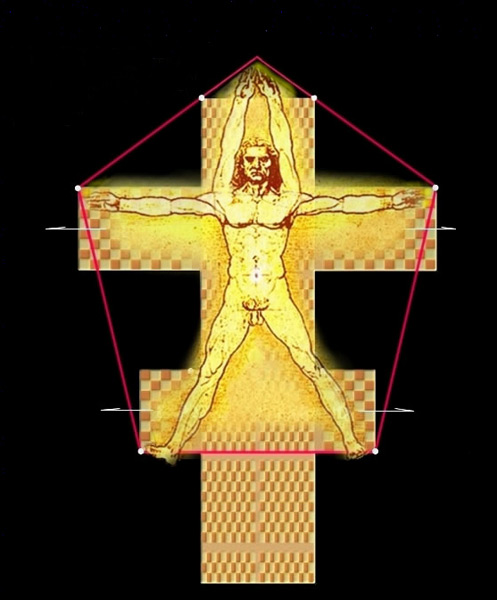 In Manly P. Hall’s 1928 book, The Secret Teachings of All Ages, Hall claims “when the upright star turns and the upper point falls to the bottom, it signifies the fall of the Morning Star.”
In Manly P. Hall’s 1928 book, The Secret Teachings of All Ages, Hall claims “when the upright star turns and the upper point falls to the bottom, it signifies the fall of the Morning Star.”
The disturbing significance of this will soon become clear.
I had also noticed a curious mistake in the order of the stars in Rosslyn’s star course. Instead of forming a perfect checkerboard, the sixth and seventh rows faced each other, thereby reversing that order. I then suggested that this reversal was meant to symbolize a day that many far-flung world mythologies say “the sky fell,” a day of cataclysm that Christians are taught to believe was the biblical flood, unleashed upon the peoples of Earth, by God Almighty, as punishment for their wickedness.
Could it be that the upside-down Lorraine Cross, Herschel’s Vitruvian Man in the pentagram, and the mistake in the order of the stars in Rosslyn’s ceiling were meant to act in concert to symbolize, for those with eyes to see, the darkest secret in the world—that we live on a flawed planet?
In Plato’s The Statesman, the philosopher has this to say about the various cataclysmic tales:
“All these stories and others still more extraordinary have their source in one and the same event. At certain periods the universe has it’s present circular motion, and after long intervals, this motion shifts such that during other periods it revolves in a contrary direction and inevitably at the time this reversal takes place, there is a great destruction of animals in general and only a small part of the human race survives.
“In his Timaeus, Plato continues that “there have been many and diverse destructions of mankind. We know this because we possess the records of those who witnessed the events and survived. Now the stories as they are told have the fashion of a legend, but the truth of them lies in the shifting of the bodies in the heavens that recurs at long intervals.”
In other words, Plato was implying that these “many and diverse destructions of mankind” were cataclysms of a cyclical nature. His “shifting of the bodies in the heavens” may have been witnessed, as he says, but it would have been the Earth the witnesses stood on that was moving, not the heavens. His scenario also brings into philosophical doubt the existence of either a perfect creator or a merciful god.
I have recently been in touch with Gary Osborn, whose forthcoming book, The Axis of God, will talk in fascinating detail about a recurring symbol he has discovered in an astonishing number of famous artworks, including those of Nicolas Poussin of “Et in Arcadia Ego” fame—the angle of 23.5 degrees. This angle, he reminds us, is the angle that the Earth is presently tipped at—a phenomenon that gives our planet its four seasons, and enables us to judge the passage of time, short or long, by the observably changing positions of the heavenly bodies throughout the year and, indeed, over the millennia.
Why would these artists encode the angle of the Earth’s tilt into their works? Was it simply to prove that they had greater knowledge than history has given them credit for, or was it for another reason? Could they have been warning us that the Earth’s tilt was not natural—that it had changed more than once before, and would change more than once again? Could they have been saying, in their quietly cryptic way, that cyclical cataclysms had not only happened, but also were predictable?
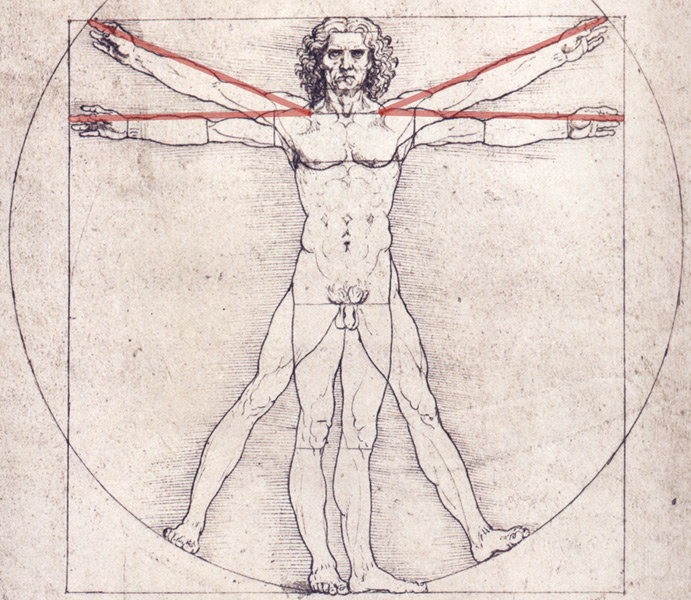 Taking a cue from Osborn’s astounding observation and my theory that the symbology of the Rosslyn Chapel ceiling was put in place to draw attention to a “day the sky fell,” I decided to look for the 23.5-degree angle in Da Vinci’s Vitruvian Man. Remarkably, it was there. The angles between the man’s two left arms and two right arms, when connected to the prominent dots that Leonardo had so very obligingly drawn at the lower corners of the square delineating the proportions of his man’s head, measured exactly 23.5 degrees!
Taking a cue from Osborn’s astounding observation and my theory that the symbology of the Rosslyn Chapel ceiling was put in place to draw attention to a “day the sky fell,” I decided to look for the 23.5-degree angle in Da Vinci’s Vitruvian Man. Remarkably, it was there. The angles between the man’s two left arms and two right arms, when connected to the prominent dots that Leonardo had so very obligingly drawn at the lower corners of the square delineating the proportions of his man’s head, measured exactly 23.5 degrees!
Wayne Herschel, while showing how the proportions of a body can delineate a pentagram, had eliminated the angle that Da Vinci had encoded. While I cautiously suggest that Herschel’s thesis will eventually maintain that human life on Earth came from elsewhere in the universe (a theory I and others subscribe to), my focus in this article is not to show where humankind came from so much as where it might be headed.
While Da Vinci’s Vitruvian Man does not show the arms extended overhead, Marcus Vitruvius Pollio has this to say in his De Architectura, the only major book on architecture that survives from classical antiquity:”The navel is naturally placed in the centre of the human body, and, if in a man lying with his face upward, and his hands and feet extended, from his navel as the centre, a circle be described, it will touch his fingers and toes.”Let’s now reconsider Herschel’s crucifixion of his Vitruvian Man on the upside-down Cross of Lorraine, noting that the location of the man’s navel, as shown in Herschel’s graphic, lies between the second and third courses of the ceiling.
Freemasons Robert Lomas and Christopher Knight, in their 1996 book The Hiram Key, focus their attentions elsewhere. After speculating that the ground plan of Rosslyn Chapel mirrors that of Herod’s Temple, they calculate that an invisible Seal of Solomon, more commonly known as the Star of David, can be drawn above the floor within the chapel’s exacting architectural measurements, and draw the reader’s attention to a carved pendulum known as the Sinclair Engrailed Boss which hangs directly overhead:
“At the very centre of this invisible Seal of Solomon,” they say, “in the arched roof there is a large suspended boss in the form of a decorated arrowhead that points straight down to a keystone in the floor below. It is, we believe, this stone that must be raised to enter the reconstructed vaults of Herod’s Temple and recover the Nasorean Scrolls.”
Lomas and Knight base their theory on the words of the first Templars as given in their fraternity’s Royal Arch Degree,” which read as follows:
“We determined to examine it [the vaults of Herod’s Temple], for which purpose we removed two of the stones, when we discovered a vault of considerable magnitude, and immediately cast lots who should descend. The lot fell on me; when, lest any noxious vapours or other causes should render my situation unsafe, my companions fastened this cord or life line round my body, and I was duly lowered into the vault. On arriving at the bottom, I gave a preconcerted signal, and my companions gave me more line, which enabled me to traverse the vault; I then discovered something in the form of a pedestal and felt certain marks or characters thereon, but from the want of light I was unable to ascertain what they were. I also found this scroll, but from the same cause I was unable to read its contents. I therefore gave another preconcerted signal, and was drawn out of the vault, bringing the scroll with me. We then discovered from the first sentence that it contained the records of the Most Holy Law, which had been promulgated by our God at the foot of Mount Sinai.”
Well, who knows? Most books have a climax, and that was theirs.
No book, however, has brought more attention to Rosslyn Chapel than Dan Brown’s “The Da Vinci Code.” Because of that book’s enormous readership, guides at Rosslyn must now explain why there is no Star of David carved into the chapel’s floor, even though Brown clearly based his suggestion on Lomas and Knight’s speculations. There can be no doubt that what the questing public wants to get into are Rosslyn’s sealed vaults. Perhaps, when the current ticket sales start to decline, those seals will open—but that might take some time.
If there is indeed an invisible Vitruvian Man, however, crucified on the upside-down Lorraine Cross encoded in Rosslyn Chapel’s ceiling, then we must again consider the importance Marcus Vitruvius Pollio and Leonardo Da Vinci placed on the navel as the center of the circle.
If the navel of the Vitruvian Man is the center of the circle, then the positioning of Herschel’s Vitruvian Man presents us with a bit of a conundrum. While Lomas and Knight position the Sinclair Engrailed Boss above the center of their invisible Seal of Solomon, the Sinclair Engrailed Boss can be seen to be located in an empty and relatively insignificant space between the Vitruvian Man’s legs, between the third and fourth courses.
Could it be that the Vitruvian Man’s navel, between the second and third courses of the ceiling, hangs directly above another significant spot in the floor below? Perhaps beneath that spot is ancient documentation of humankind’s true past, as well as its destiny. Again, we shall have to wait until the vaults are opened.
In the meantime, no matter what might lie below, there’s plenty more to see above.
Marcus Vitruvius Pollio decreed, in the 1st century BC, that great buildings should be built with the proportions of nature in mind. It is therefore not surprising that the ideal proportions of a human body would be incorporated into Rosslyn’s ceiling. What is surprising, however, is that the flaw in the order of the star course in Rosslyn’s ceiling would hint that civilization, as stated by Plato, is periodically destroyed by a cyclical cataclysm, and that the 23.5-degree angle found between the arms of Da Vinci’s Vitruvian Man would hint at the very same thing.
In his recently published “The Giza Oracle,” Glasgow-based writer Scott Creighton tips his hat to Gary Osborn’s 23.5-degree thesis and, although he reaches his conclusions from a different direction, concurs that the ancients took great pains to make sure that the truth about Earth’s cataclysmic history was encoded in the careful relative positioning of some of the world’s most awe-inspiring structures. Creighton places Rosslyn Chapel high on his list of those structures, and I must agree.
On the south side of the star course of Rosslyn’s ceiling are four architectural elements worthy of note—a sun, a dove, a moon, and a bearded head with a hand raised alongside. While two of those elements have been somewhat modified since as recently as 1892, as I talk at greater length about in my AR #38 “Secrets of Rosslyn Chapel,” the relative positions of those elements, one to the other, have not—and it is in those positions that further proof of Rosslyn’s darkest secret lies.
A line drawn between the moon and the sun creates an angle of exactly 23.5 degrees—a clear, indeed blatant reference to the positions of the heavenly bodies relative to Earth’s axial tilt that has been hidden in plain sight for centuries.
Whether or not our Earth once spun without a tilt, enjoying a “Golden Time” of endless Atlantean summer, and was knocked off kilter at the hand of a less-than-merciful god, a comet, an asteroid, a magnetic pole shift, the return of Zecharia Sitchin’s 12th Planet, or whatever planetary upheaval any combination of the above might visit upon us, it is not likely that so much effort would be put into telling us that our home had suffered a one-in-a-million-chance cataclysm. Since you can’t change chance, why bother?
It is far more likely they were warning us that the cataclysm documented in our “myths” had happened before, and would certainly happen again. In doing so they were showing that they cared more about us, then, than we seem to care about each other, now.
Perhaps they knew that all of us, no matter where we live or what god we have been taught to pray to, were adrift on the same rocky boat.Shouldn’t we have learned, by now, how to row together?
— END —
POSTCRIPT
While I did not know it at the time the article went to press, I was soon informed that the 23.5-degree angle, and it’s 47-degree double, are two of Freemasonry’s “Cosmic Angles,” according to Frank C. Higgins in his 1919 book, Ancient Freemasonry: An Introduction to Masonic Archaeology. Higgins goes on to say that these angles are also encoded on coins showing pre-Christian Phoenician temples of Cypress, ancient Greek paintings of Hermes and Ceres, as well as in the Masonic Keystone and Compass of the present day. This was, of course, in Higgins’ “present day.” Today’s Masonic compasses are opened to 60 degrees.
It is interesting, however, that the 23.5-degree angle has become a part of modern-day Masonic ritual. In a 1998 Masonic Manual and Monitorial Instructions booklet I have consulted is a section titled “Manual of the Rod,” abridged as follows:
“The rods are carried by the Deacons and Stewards as emblems of Office. They are carried in the performance of official duties, either directed or implied, from the sound of the gavel which congregates the Lodge to the sound of the gavel which closes the Lodge … While they are marching, they carry the rod between the upper arm and the body, inclining it forward at an angle of 23 and one-half degrees …”
The Masonic Manual, though highly interesting in its entirety, does not elaborate on the significance of that angle, but I have been told that many Masons do in fact know that this is the angle of the tilt of the Earth.
I have been unable to discover whether those same Masons know why such an angle is considered important enough to be a part of their ritual, or whether they are simply satisfied that it is.
I suspect that the knowledge is very carefully parceled out, by degrees.
